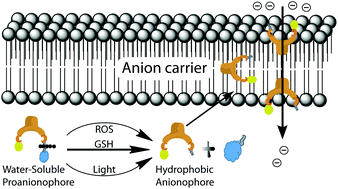Multi-stimuli controlled release of a transmembrane chloride ion carrier from a sulfonium-linked procarrier†
Abstract
In recent times, anion transporters have received substantial consideration due to their ability to disrupt the ionic equilibrium across membrane bilayers. While numerous Cl− ion transporters were developed for channelopathies, unfortunately, poor aqueous solubility precluded their bioapplicability. Herein, we demonstrate the development of a multi-stimuli activatable anion transport approach to induce regulated transport of Cl− ions across membranes under specific conditions. The sulfonium-based procarrier was initially inactive, but the transmembrane transport of Cl− ions was activated in the presence of stimuli such as glutathione (GSH), reactive oxygen species (ROS) and light. The release of the hydrophobic anionophore from the aqueous-soluble procarrier under specific conditions leads to the successful transport of Cl− ions. Under physiological conditions, these anion carriers follow an antiport exchange mechanism to transport Cl− ions across lipid bilayers. Such multi-stimuli activatable procarriers have great potential to combat various types of channelopathies, including cancer, cystic fibrosis, kidney stones, myotonia, and others.

- This article is part of the themed collection: Supramolecular chemistry in OBC


 Please wait while we load your content...
Please wait while we load your content...